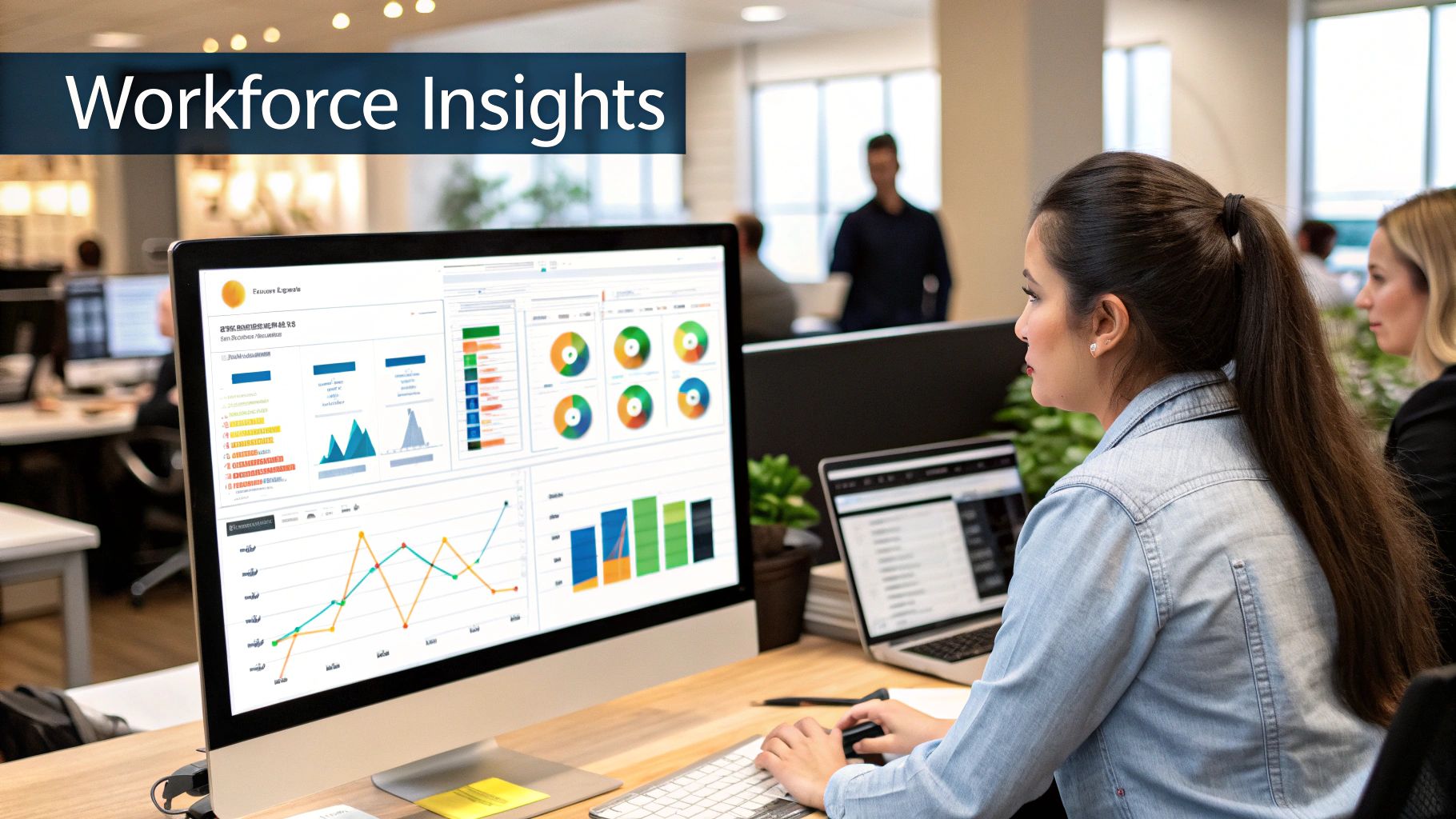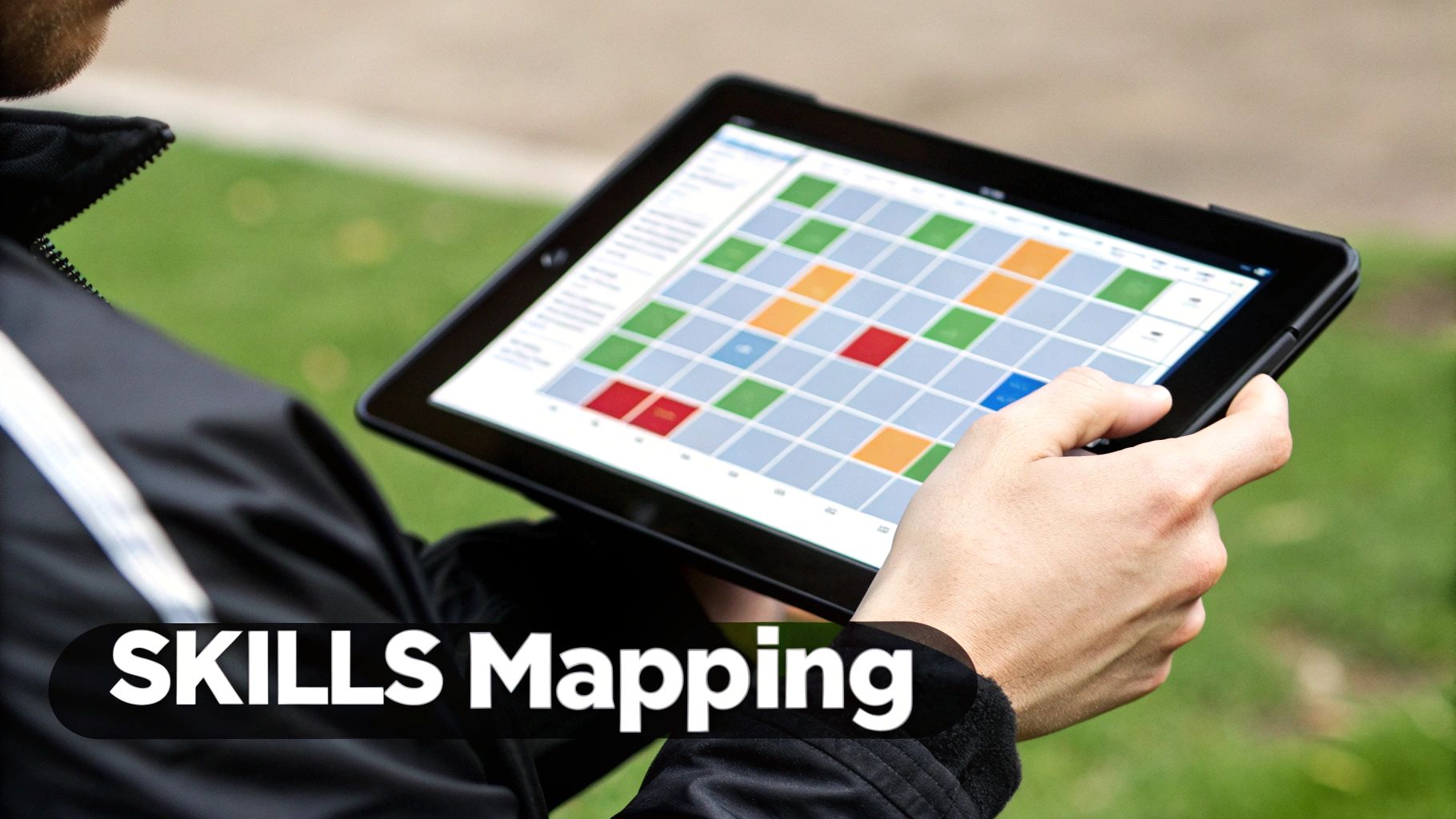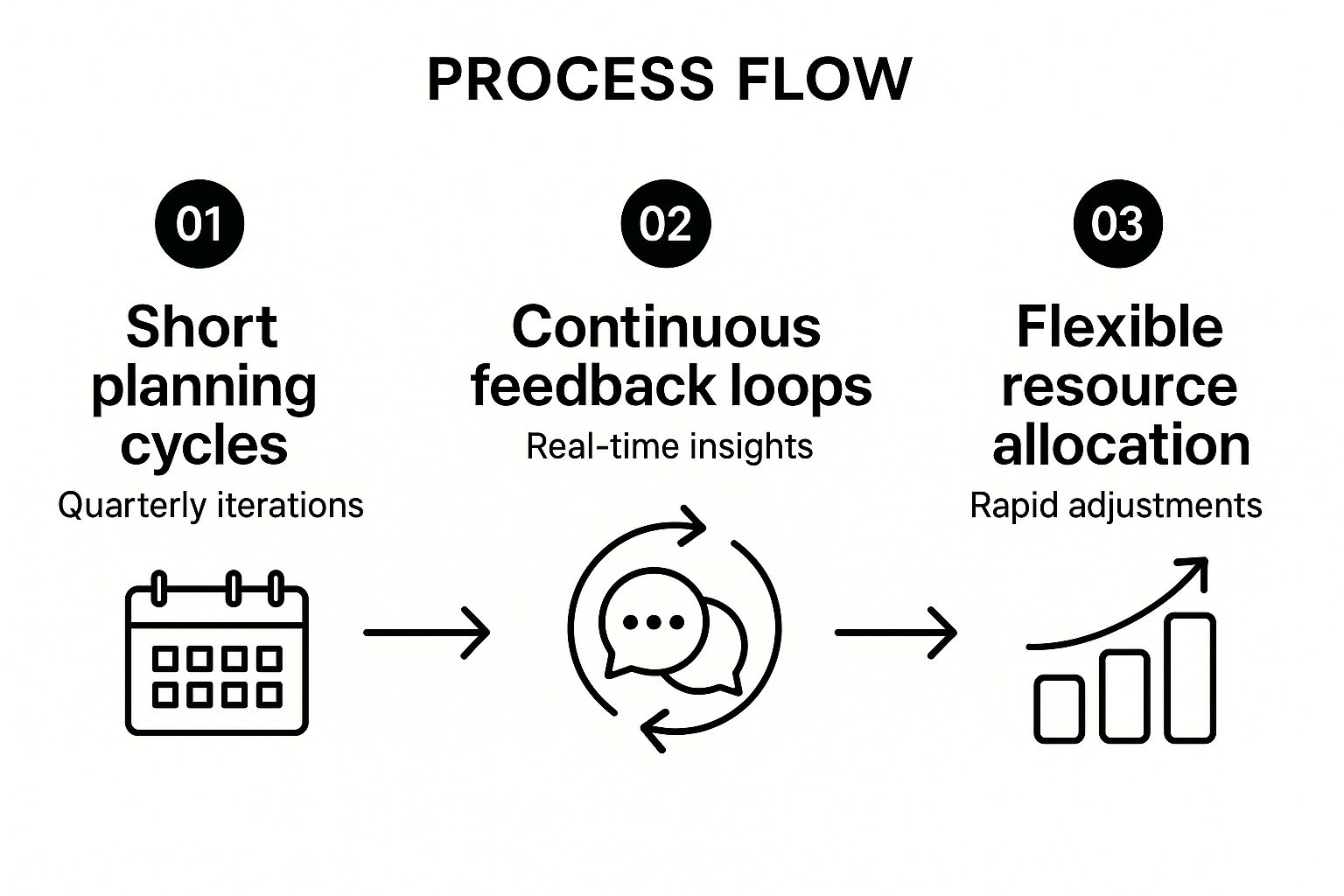7 Workforce Planning Best Practices for 2025
- Ron Smith
- Aug 7
- 14 min read
In a business environment defined by rapid technological change, the rise of AI in management, and shifting global talent markets, traditional annual headcount planning is no longer sufficient. The future belongs to organizations that can dynamically align their talent with strategic goals. This requires a new playbook, one that incorporates advanced workforce planning best practices to build a resilient, skilled, and future-ready team. To make your planning smarter and more successful, it's helpful to first explore various effective workforce planning methods.
This article moves beyond outdated approaches to embrace data-driven, agile, and skills-focused strategies. We will explore seven critical practices, from leveraging data analytics and implementing agile cycles to integrating Diversity, Equity, and Inclusion (DEI) into your core talent strategy. You will learn how emerging trends like AI in workforce management and the strategic use of contingent labor are reshaping talent acquisition.
We'll also examine how a new kind of staff augmentation, such as what we offer for global talent at the most affordable cost, provides a critical advantage. This model offers direct access to a global talent pool, enabling you to close skill gaps and achieve strategic objectives faster. Get ready to transform your approach and build a workforce prepared for 2025 and beyond.
1. Strategic Workforce Planning with Data Analytics
Strategic workforce planning has evolved far beyond simple headcount forecasting. Today, one of the most impactful workforce planning best practices involves a comprehensive approach rooted in data analytics, predictive modeling, and business intelligence. This method transforms HR from a reactive administrative function into a proactive, strategic partner that aligns talent capabilities directly with long-term organizational goals. It involves analyzing current workforce data, predicting future talent needs, and creating actionable plans to bridge anticipated gaps through targeted recruitment, upskilling, or strategic restructuring.

This data-first mindset allows organizations to make smarter, evidence-based decisions about their most valuable asset: their people. By analyzing trends in attrition, performance, and skill distribution, leaders can anticipate challenges before they arise. Effective strategic workforce planning often leverages advanced techniques; forward-thinking companies learn how to unlock business growth with predictive data analytics to stay ahead of the curve.
Real-World Success Stories
Many of today's top companies have pioneered data-driven HR.
Google's People Analytics team is famous for using data to optimize everything from hiring algorithms to employee well-being and retention strategies.
IBM's Watson Talent employs AI to forecast employee flight risk and identify high-potential candidates who might otherwise be overlooked.
Unilever successfully used predictive analytics to overhaul its graduate recruitment process, reducing the time from application to hire by an incredible 75%.
Actionable Tips for Implementation
Getting started with data-driven workforce planning doesn't require a massive initial investment.
Start with Clean Data: The foundation of any analysis is reliable data. Begin by standardizing your data collection processes for key metrics like turnover, time-to-hire, and skills.
Begin with Simple Metrics: Don't jump straight to complex AI models. Start by tracking and analyzing fundamental KPIs. As your team's data literacy grows, you can graduate to more sophisticated predictive analytics.
Invest in Training: Your HR team needs to understand how to interpret data and translate insights into action. Provide training on data analytics tools and critical thinking skills.
This approach is particularly crucial in today's fast-paced environment, where emerging trends in contingent labor and AI are reshaping talent markets. Using data helps you determine when to build, buy, or borrow talent, allowing you to leverage flexible models like a new kind of staff augmentation to access global expertise affordably and on demand.
2. Skills-Based Workforce Planning
Shifting from traditional job-based roles to a skills-based approach is one of the most transformative workforce planning best practices for modern organizations. This method prioritizes identifying, mapping, and developing specific employee competencies rather than focusing on static job titles. It involves creating a dynamic inventory of your workforce's current skills, forecasting future skill requirements tied to business objectives, and building agile strategies to acquire, upskill, or redeploy talent based on their capabilities.

This skills-centric mindset, championed by thought leaders like Josh Bersin, provides unparalleled agility. It allows companies to see talent as a fluid pool of capabilities that can be assembled and reassembled to meet evolving project needs and market demands. Instead of hiring for a rigid role, you hire for a collection of skills, unlocking internal mobility and making your organization more resilient to disruption. This is especially vital as AI and automation continually reshape job functions, making specific skills more valuable than historical job experience.
Real-World Success Stories
Leading companies have demonstrated the power of a skills-based talent strategy.
Microsoft successfully transitioned over 100,000 employees during its cloud transformation by focusing on developing future-ready skills, not just filling old roles.
AT&T invested $1 billion in a massive reskilling initiative after mapping the future skills needed to compete, retraining thousands of employees for new roles in cybersecurity and data analytics.
Accenture uses its "Skills Quotient" platform to track more than 40,000 distinct skills across its global workforce, enabling dynamic project staffing and personalized career development.
Actionable Tips for Implementation
Transitioning to a skills-based model can be done incrementally.
Start with Critical Roles: Begin by mapping the skills for a few high-impact business areas or critical job families before attempting a company-wide rollout.
Use AI-Powered Tools: Leverage technology to automate skills identification from resumes, performance reviews, and project data. These tools can also match employees to internal opportunities, reducing bias.
Create Clear Career Pathways: Build transparent career paths based on skill progression, not just promotions. Show employees exactly what skills they need to develop to advance.
This approach is crucial for effectively managing a blended workforce. When you know the exact skills you need, you can strategically decide whether to upskill an internal employee or engage contingent labor. A new kind of staff augmentation allows you to tap into a global pool of specialized skills on-demand, providing an affordable and flexible way to fill immediate competency gaps without the overhead of a full-time hire.
3. Agile Workforce Planning
Traditional annual workforce planning is becoming obsolete in a business world defined by rapid change and uncertainty. Agile workforce planning is an iterative, flexible alternative that allows organizations to adapt quickly to shifting market conditions. This essential practice emphasizes short planning cycles, continuous feedback, and cross-functional collaboration to adjust workforce strategies in real-time. Instead of rigid, long-term forecasts, it focuses on building a resilient and adaptable talent ecosystem.

This process flow visualizes the core engine of agile workforce planning: a continuous cycle of short iterations, feedback, and adjustment. By embracing this model, organizations can move from static planning to a dynamic system that responds swiftly to business needs, ensuring talent allocation remains aligned with immediate priorities. This approach is a cornerstone of a modern agile team structure and one of the most effective workforce planning best practices for volatile industries.
Real-World Success Stories
Many forward-thinking companies have successfully adopted agile principles to manage their workforce.
Spotify famously organizes its workforce into autonomous "squads" and "tribes," enabling rapid innovation and flexible resource deployment without traditional hierarchical bottlenecks.
ING Bank undertook a large-scale agile transformation, restructuring its entire organization into squads to improve customer focus and accelerate decision-making.
Haier, a multinational home appliance company, transformed its massive structure into over 4,000 self-managing micro-enterprises, empowering teams to respond directly to market demands.
Actionable Tips for Implementation
Implementing an agile approach requires a cultural shift, but you can start with targeted actions.
Establish Clear Governance: Create a lightweight but clear framework for how decisions are made, who makes them, and how resources are reallocated between cycles.
Train for Agility: Equip HR business partners and line managers with agile principles and techniques, teaching them to think in sprints and prioritize adaptable talent solutions.
Create Feedback Mechanisms: Implement tools and processes for continuous feedback from business units to HR, ensuring workforce plans are constantly refined with real-world data.
Agility is crucial for leveraging emerging trends like the contingent workforce. An agile model allows you to integrate on-demand talent seamlessly, using a new kind of staff augmentation to "borrow" specialized skills for specific projects without the overhead of permanent hires. This keeps your core team lean while giving you access to a global pool of expertise at the most affordable cost.
4. Scenario-Based Workforce Planning
In a world defined by volatility and rapid change, relying on a single future forecast is no longer a viable strategy. Scenario-based workforce planning is a best practice that moves beyond linear predictions to prepare for multiple potential futures. This approach, pioneered by thinkers like Pierre Wack at Royal Dutch Shell, involves creating detailed, plausible narratives about how the business environment might evolve and then developing corresponding workforce strategies for each scenario. It's about asking "what if?" and having a plan ready, regardless of the answer.
This strategic foresight allows organizations to build resilience and agility into their talent models. Instead of being caught off guard by market disruptions, technological shifts, or regulatory changes, companies can pivot their workforce strategies proactively. This is a cornerstone of modern workforce planning best practices, enabling leaders to anticipate talent needs under various conditions, from best-case growth to worst-case downturns.
Real-World Success Stories
Organizations across industries have used scenario planning to navigate uncertainty.
Royal Dutch Shell famously used this method to anticipate the oil crisis of the 1970s, applying the same logic to plan its workforce for massive energy transitions and market fluctuations.
Airlines leveraged scenario planning during the COVID-19 pandemic to model drastic shifts in travel demand, helping them make difficult decisions about pilot and crew staffing, furloughs, and eventual rehiring.
Financial Services Firms regularly use scenarios to plan for the impact of digital transformation and new regulations, mapping out the skills they will need to build or acquire to remain competitive.
Actionable Tips for Implementation
Implementing scenario-based planning requires a structured yet creative approach.
Involve Diverse Stakeholders: Bring together leaders from finance, operations, marketing, and technology, not just HR. Diverse perspectives are crucial for creating rich, realistic scenarios.
Focus on Actionable Scenarios: Avoid purely academic exercises. Each scenario should be tied to specific business drivers and result in a clear set of workforce actions.
Develop Clear Triggers: Define the specific market signals or internal metrics that would indicate a particular scenario is unfolding. These triggers will prompt the activation of your contingency plans.
Update Scenarios Regularly: The future is not static. Revisit and revise your scenarios quarterly or semi-annually to incorporate new information and emerging trends.
This forward-looking practice is essential for integrating emerging talent models. By modeling scenarios that include greater reliance on contingent labor or specialized AI skills, organizations can better understand when to deploy flexible solutions. A new kind of staff augmentation can be a key enabler, providing the on-demand access to global expertise needed to execute a scenario-based plan affordably and at scale.
5. Integrated Business and Workforce Planning
One of the most critical workforce planning best practices is moving beyond siloed HR activities to a fully integrated model. Integrated business and workforce planning aligns your people strategy directly with core business objectives, financial forecasts, and operational plans. This holistic approach ensures that every talent decision, from hiring to development, supports broader organizational goals. It treats workforce planning not as a separate HR function, but as an indispensable component of the company's central strategic engine, ensuring that people capabilities drive business outcomes.

This synergy prevents the common disconnect where business units set ambitious goals without the necessary talent to achieve them. By embedding HR leaders and workforce data into the strategic planning cycle, companies can proactively address talent needs, manage labor costs more effectively, and enhance organizational agility. This concept has been championed by thought leaders like Dave Ulrich through his HR business partner model and further developed by frameworks from organizations like Deloitte.
Real-World Success Stories
Leading companies demonstrate the power of integrating people and business strategy.
Amazon masterfully aligns its workforce planning with operational and logistical forecasts to scale its seasonal workforce for peak periods like Prime Day and the holiday season.
Procter & Gamble (P&G) embeds workforce considerations as a key pillar in its integrated business planning process, ensuring talent supply meets product demand.
Netflix directly ties its workforce planning to its content creation strategy and global expansion plans, hiring specialized talent in new markets just as new productions are greenlit.
Actionable Tips for Implementation
Integrating your planning processes requires intentional effort and cross-functional collaboration.
Align Planning Cycles: Synchronize your workforce planning schedule with the company's annual business and financial planning cycles to ensure conversations happen in tandem.
Establish Formal Governance: Create a cross-functional committee with leaders from HR, Finance, and Operations to oversee the integrated planning process and ensure shared accountability.
Use Shared Tools and Dashboards: Utilize common data sources and integrated reporting dashboards that display both business metrics and workforce KPIs side-by-side for a unified view.
This integrated approach is essential for navigating modern talent dynamics, where AI advancements and the rise of contingent labor are reshaping how work gets done. It enables you to strategically decide when to build internal skills versus when to leverage flexible models like a new kind of staff augmentation to access specialized global expertise at the most affordable cost.
6. Diversity, Equity, and Inclusion (DEI) in Workforce Planning
Effective workforce planning best practices must go beyond filling roles; they must build a workforce that reflects the diverse world we live in. Integrating Diversity, Equity, and Inclusion (DEI) into the core of your workforce planning is not just a social imperative but a strategic advantage. This practice involves embedding DEI principles into every stage, from forecasting future needs and analyzing current demographics to developing talent pipelines and succession plans. It means proactively setting diversity goals, identifying and dismantling systemic barriers, and ensuring all talent segments have equitable opportunities for growth and advancement.
A truly inclusive approach transforms workforce planning from a quantitative exercise into a qualitative one that builds a richer, more innovative, and resilient organization. To truly embed DEI into your workforce planning, it's essential to focus on inspiring inclusion throughout your organizational culture, making it a lived reality for every employee. This focus ensures that your planning efforts translate into a genuinely welcoming environment where diverse talent can thrive.
Real-World Success Stories
Leading companies demonstrate how to operationalize DEI in workforce planning.
Johnson & Johnson implements a "diverse slate" approach, mandating that candidate pools for leadership positions include a diverse mix of individuals, directly influencing hiring outcomes.
Salesforce conducts regular equal pay audits and uses the findings to inform its workforce planning and compensation strategies, ensuring pay equity is a continuous priority.
Intel famously committed $300 million to its Diversity in Technology initiative, setting specific, public targets for increasing the representation of women and underrepresented minorities in its workforce.
Actionable Tips for Implementation
Embedding DEI into your workforce planning is a deliberate and ongoing process.
Set Measurable Targets: Establish clear, data-driven diversity goals for different levels and departments. Track representation, promotion rates, and attrition across demographic groups.
Train Planning Teams: Educate HR and leadership on unconscious bias, inclusive language, and equitable evaluation processes to mitigate bias in decision-making.
Leverage Data to Find Gaps: Use analytics to pinpoint where diverse talent is underrepresented or facing barriers to progression and develop targeted interventions.
Establish Accountability: Link leadership bonuses and performance reviews to the achievement of DEI outcomes, creating shared responsibility for progress.
This strategic approach is critical for tapping into the full spectrum of global talent. By prioritizing DEI, you can build stronger, more effective teams. Developing strong cross-cultural communication skills is fundamental to making this a success, especially when leveraging a global, contingent workforce.
7. Continuous Workforce Planning
The traditional model of workforce planning as an annual, static exercise is no longer sufficient in today's volatile business landscape. One of the most critical workforce planning best practices for modern organizations is adopting a continuous, agile approach. This treats workforce planning not as a one-time event, but as an ongoing, dynamic process that constantly adapts to shifting business priorities, market conditions, and technological advancements. It involves real-time monitoring of workforce metrics, regular plan adjustments, and continuous engagement with business leaders to ensure talent strategies remain aligned with organizational needs.
This agile mindset enables organizations to respond swiftly to both opportunities and threats. By continuously analyzing data on performance, skills, and engagement, HR can proactively address emerging talent gaps or surpluses. This is particularly vital when dealing with rapid changes, such as the integration of AI into workflows or the need to scale specialized teams quickly. A continuous approach allows for a more flexible talent strategy, making it easier to leverage contingent labor or global talent pools to meet immediate demands without long-term commitments.
Real-World Success Stories
Leading companies demonstrate the power of an adaptive planning cycle.
Netflix continuously plans its workforce to support its aggressive global expansion and ever-changing content production pipeline, ensuring the right creative and technical talent is available in new markets.
Uber uses real-time data to optimize its driver workforce, balancing supply with fluctuating rider demand across thousands of cities worldwide.
Adobe replaced its annual review process with a continuous performance management system ("Check-in") that feeds directly into its ongoing workforce and succession planning efforts.
Actionable Tips for Implementation
Transitioning to a continuous model requires a shift in both process and culture.
Implement Automated Dashboards: Use HR tech to create real-time dashboards that track key metrics like skill gaps, attrition rates, and project staffing levels. Automation frees up your team to focus on strategy instead of manual data collection.
Establish a Review Cadence: Set up regular, frequent check-ins (e.g., quarterly or even monthly) with business units to review workforce plans and make necessary adjustments based on current data and forecasts.
Focus on High-Impact Metrics: Avoid analysis paralysis by concentrating on the handful of metrics that most directly influence business outcomes, such as time-to-productivity for new hires in critical roles.
This continuous model is essential for organizations that need to scale efficiently and stay competitive. For tech companies, successfully scaling engineering teams without the chaos requires this level of agile planning to integrate specialized talent seamlessly. Adopting this practice helps you build a resilient organization that can pivot quickly, whether by upskilling internal teams or engaging on-demand global talent.
7 Best Practices in Workforce Planning Compared
Workforce Planning Approach | Implementation Complexity | Resource Requirements | Expected Outcomes | Ideal Use Cases | Key Advantages |
|---|---|---|---|---|---|
Strategic Workforce Planning with Data Analytics | High - requires advanced tech & training | Significant investment in data systems and analytics expertise | Proactive decisions, improved ROI, reduced hiring costs | Large organizations with complex workforce needs | Talent optimization, competitive advantage |
Skills-Based Workforce Planning | Moderate to High - cultural shift & mapping | Investment in skills taxonomy tools and AI | Increased agility, maximized talent utilization, reduced external hires | Organizations focusing on competency development | Organizational adaptability, employee engagement |
Agile Workforce Planning | Moderate - requires cultural buy-in | Requires training in agile methods and change management | Quick adaptation, enhanced collaboration, aligned priorities | Fast-changing markets needing flexibility | Rapid adjustments, reduced bureaucracy |
Scenario-Based Workforce Planning | High - involves extensive scenario creation | Requires expertise and time for scenario development | Preparedness for uncertainty, risk reduction, resilience | Industries facing volatility and uncertainty | Better risk management, proactive planning |
Integrated Business and Workforce Planning | High - cross-functional integration needed | Requires collaboration tools and executive support | Workforce aligned with business goals, better resource use | Businesses seeking tight alignment between HR and business strategy | Improved budget accuracy, departmental collaboration |
Diversity, Equity, and Inclusion (DEI) in Workforce Planning | Moderate to High - cultural and process changes | Investment in DEI training, data analytics | Improved diversity, reduced risks, greater innovation | Organizations prioritizing inclusive workplace cultures | Enhanced innovation, talent attraction |
Continuous Workforce Planning | High - ongoing process requiring robust tech | Requires real-time analytics and continuous monitoring | Rapid responsiveness, current plans, increased agility | Environments with frequent changes and dynamic needs | Planning relevance, improved forecast accuracy |
Unlocking Your Global Talent Potential with a New Kind of Staff Augmentation
Navigating the future of work requires more than just foresight; it demands a dynamic and intelligent approach to talent strategy. We've explored the essential workforce planning best practices that transform HR from a reactive function into a proactive, strategic powerhouse. From harnessing data analytics and embracing agile methodologies to embedding DEI principles at the core of your planning, each practice is a vital component of building a resilient, future-ready organization.
The common thread weaving through these modern strategies is the need for flexibility and access to specialized skills. The days of relying solely on traditional, full-time hiring cycles are over. The most effective workforce planning today acknowledges the critical role of a blended workforce, integrating full-time employees with high-caliber contingent talent to meet evolving business demands. This is where the true power of strategic planning comes to life, allowing you to adapt to market shifts, technological advancements like AI, and unforeseen challenges with confidence and precision.
From Strategy to Execution: Bridging the Talent Gap
Putting these workforce planning best practices into action can seem daunting, especially for midsize companies or startups competing for top-tier talent. The operational overhead of sourcing, vetting, and managing a global or contingent workforce can quickly overwhelm internal teams. This is the precise gap that emerging talent solutions are built to fill.
The rise of AI in talent acquisition and the strategic use of contingent labor are not just trends; they are foundational shifts in how work gets done. A new kind of staff augmentation, which we offer, provides the missing link between your strategic plans and on-the-ground execution. Instead of building massive internal recruiting teams or juggling multiple vendors, you can leverage a single partner to access a global pool of pre-vetted professionals at the most affordable cost.
This model acts as an all-in-one solution, handling the complexities of international sourcing, rigorous vetting, payroll, and compliance. This allows you to:
Execute Agile Planning: Instantly scale your engineering teams up or down in response to project needs, without the long-term commitment of a direct hire.
Fill Critical Skills Gaps: Quickly find and onboard niche tech talent for specific projects, ensuring your skills-based planning translates into tangible results.
Implement Scenario Plans: Seamlessly add talent to test new market entries or product ideas without significant upfront investment in permanent headcount.
By integrating this new kind of staff augmentation, you transform your meticulously crafted workforce plans from static documents into living, breathing strategies. You gain the operational agility to focus on high-level goals, while your talent partner handles the tactical complexities of global talent acquisition. This makes building a world-class, globally distributed team not only possible but also affordable and efficient.
Ready to turn your strategic workforce plans into a competitive advantage? Discover how shorepod's new kind of staff augmentation can help you build and manage an elite global engineering team effortlessly. Visit shorepod to access pre-vetted global talent at the most affordable cost and streamline your international hiring today.